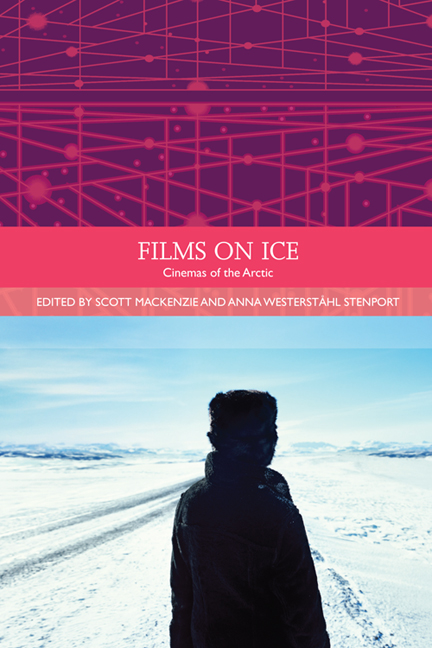Book contents
- Frontmatter
- Contents
- List of Illustrations
- Acknowledgements
- Traditions in World Cinema
- Introduction: What are Arctic Cinemas?
- PART I GLOBAL INDIGENEITY
- PART II HOLLYWOOD HEGEMONY
- 8 Fact and Fiction in ‘Northerns’ and Early ‘Arctic Films’
- 9 California's Yukon as Comic Space
- 10 ‘See the Crashing Masses of White Death…’: Greenland, Germany and the Sublime in the ‘Bergfilm’ SOS Eisberg
- 11 The Threat of the Thaw: The Cold War on the Screen
- 12 Hollywood Does Iceland: Authenticity, Genericity and the Picturesque
- 13 White on White: Twenty-First-Century Norwegian Horror Films Negotiate Masculinist Arctic Imaginaries
- PART III ETHNOGRAPHY AND THE DOCUMENTARY DILEMMA
- PART IV MYTHS AND MODES OF EXPLORATION
- Notes on the Contributors
- Index
11 - The Threat of the Thaw: The Cold War on the Screen
from PART II - HOLLYWOOD HEGEMONY
Published online by Cambridge University Press: 05 September 2016
- Frontmatter
- Contents
- List of Illustrations
- Acknowledgements
- Traditions in World Cinema
- Introduction: What are Arctic Cinemas?
- PART I GLOBAL INDIGENEITY
- PART II HOLLYWOOD HEGEMONY
- 8 Fact and Fiction in ‘Northerns’ and Early ‘Arctic Films’
- 9 California's Yukon as Comic Space
- 10 ‘See the Crashing Masses of White Death…’: Greenland, Germany and the Sublime in the ‘Bergfilm’ SOS Eisberg
- 11 The Threat of the Thaw: The Cold War on the Screen
- 12 Hollywood Does Iceland: Authenticity, Genericity and the Picturesque
- 13 White on White: Twenty-First-Century Norwegian Horror Films Negotiate Masculinist Arctic Imaginaries
- PART III ETHNOGRAPHY AND THE DOCUMENTARY DILEMMA
- PART IV MYTHS AND MODES OF EXPLORATION
- Notes on the Contributors
- Index
Summary
Erected in 1961, the Berlin Wall is an artifact of the geopolitical tensions that marked the period of 1947–89. Initially constructed of bricks and barbed wire, and subsequently by large forbidding concrete slabs, the wall symbolised the ideological and political differences between communism and capitalism, the Warsaw Pact and NATO, and the USSR and the USA. Like other associated terms – such as the East and West blocs, or the Iron Curtain, or the Cold War – the wall helpfully bridged two conceptual realms: the material and the imaginary. It became an expedient way to conceptualise a prolonged conflict that by the early 1960s seemed eerily abstract and all-encompassing: sterile and frigid yet always on the verge of dynamic escalation and ensuing mass destruction. Though wars in Korea, Vietnam and Afghanistan had pitched the two powers against each other in destructive interactions that wreaked long-term havoc on small nations, the mainstream Western cultural imaginary of the Cold War was largely detached from embodied practices or localised combat. The Cold War was everywhere and simultaneously nowhere.
The space race escalated from the mid-1950s onward and extended outward from Earth itself. Culminating in the early 1980s, with Reagan's Strategic Defense Initiative (SDI) or ‘Star Wars’ programme (in a nod toward the significance of the cinematic imagination for shaping the Cold War), the Cold War's airborne military operations defied national boundaries, just as it did when it was waged underwater, in deadly nuclear submarines circling the earth, unseen by the public though charted on radar screens. Visualisations of such threats figured prominently in Cold War cinema, with situation rooms filled with blinking screens charting airborne progress or thwarted oceanic attacks a staple of the mise-en-scene (Shaw and Youngblood 2010; Palmer 2011; Shaw 2007). Films made in, about or alluding to the Arctic region and its distinctive environments and geopolitical tensions offer important perspectives for visualising a Cold War cultural imaginary. The Arctic through its climate – its coldness – and its distinctive environment – ice – can be understood as an emblem for the Cold War. This is evident in a range of films from the period, spanning European co-productions to Mosfilm and Hollywood, and, in the case of American TV, military documentary broadcasts.
- Type
- Chapter
- Information
- Films on IceCinemas of the Arctic, pp. 161 - 175Publisher: Edinburgh University PressPrint publication year: 2014



